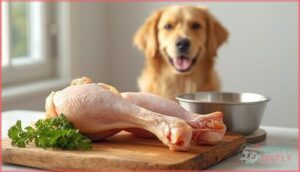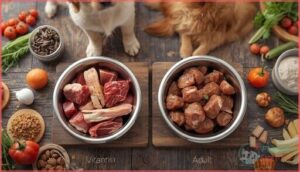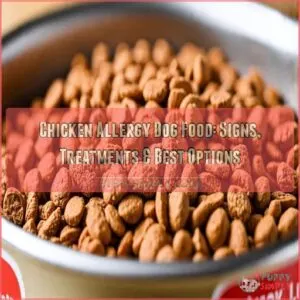This site is supported by our readers. We may earn a commission, at no cost to you, if you purchase through links.
Most commercial dog foods contain ingredients your dog’s wild ancestors would never recognize—corn syrup, meat byproducts, and synthetic preservatives processed at temperatures that destroy natural enzymes. Raw dog food for beginners offers a different approach, one that mirrors what canines ate for thousands of years before kibble existed.
The concept is straightforward: feed your dog fresh muscle meat, organ meats, raw bones, and select vegetables in their natural, uncooked state. This biologically appropriate diet puts you in control of every ingredient that enters your dog’s bowl, eliminating the guesswork and questionable additives found in many processed foods.
The shift requires careful planning, safe handling practices, and a solid understanding of nutritional balance, but the potential benefits—from shinier coats to improved digestion—make it worth considering for dogs with chronic health issues or owners seeking greater dietary control.
Table Of Contents
- Key Takeaways
- What is Raw Dog Food?
- Benefits of Feeding Raw Dog Food
- Is Raw Dog Food Safe and Healthy?
- Choosing Ingredients for Raw Dog Diets
- How to Transition Your Dog to Raw Food
- Meal Planning and Portion Guidelines
- Top Products for Raw Dog Food Beginners
- Frequently Asked Questions (FAQs)
- What is the difference between raw and cooked dog food?
- Can raw dog food be stored in the fridge?
- How do I transition my dog to a raw food diet?
- Is it safe to feed my dog raw bones?
- What are the benefits of a raw food diet for dogs?
- How much does raw dog food cost monthly?
- Can senior dogs switch to raw food safely?
- What equipment do I need for raw feeding?
- How do I find a reputable raw food supplier?
- Conclusion
Key Takeaways
- Raw dog food mimics your dog’s ancestral diet by using uncooked muscle meat, organs, raw bones, and vegetables—eliminating processed fillers while giving you complete control over every ingredient that enters their bowl.
- You’ll likely see tangible improvements within weeks, including shinier coats, 70–87% less dental tartar buildup, firmer stools, and 95.71% nutrient absorption compared to kibble’s 57.11%.
- Bacterial contamination poses real risks—87% of chicken-based raw samples test positive for E. coli—so you must follow strict handling protocols including refrigeration below 40°F, dedicated utensils, and immediate cleanup.
- Successful raw feeding requires precise nutritional balance (58–80% muscle meat, 10% organs, 10% raw meaty bones, 7–20% vegetables) and gradual transition over 7–14 days to avoid digestive upset while monitoring your dog’s response closely.
What is Raw Dog Food?
Raw dog food takes your pet’s diet back to basics, mimicking what dogs ate before kibble became the norm. It’s built on fresh, uncooked ingredients like muscle meat, organs, and bones, with no processed fillers in sight.
Let’s break down what raw feeding actually means, what goes into the bowl, and how the BARF approach ties it all together.
Definition and Philosophy Behind Raw Feeding
Raw dog food—often called BARF Diet or raw meat-based diets—mimics the ancestral diet wild canines evolved eating: uncooked muscle, organs, bones, and occasional plant matter. This natural feeding principle emerged from the biologically appropriate diet philosophy, believing your dog’s digestive system thrives on raw food origins rather than processed kibble.
It’s canine health and nutrition stripped back to wild canine nutrition fundamentals, putting you in control of what fuels your pet. Understanding barf diet risks is vital for a smooth shift to raw dog food.
Key Components—Meat, Organs, Bones, Vegetables
A solid raw food diet starts with muscle meat—your protein powerhouse—making up 58–80% of each meal. Add 10% organ balance (split between liver and other organs like kidney or spleen) for essential vitamins, then 10% raw meaty bones for bone health and calcium. Round it out with 7–20% vegetable variety—leafy greens, carrots—for fiber and antioxidants.
Getting your nutrient ratio right transforms raw feeding for dogs into a true dog nutrition win. Ensuring the right balanced diet approach is vital for a dog’s overall health.
BARF Diet Explained
You’ve nailed the basic building blocks—now let’s talk about the BARF diet, short for Biologically Appropriate Raw Food. This raw nutrition approach mimics canine evolution, emphasizing:
- Raw meaty bones, organs, and muscle meat as core ingredients
- Minimal carbohydrates, with feeding guidelines excluding grains entirely
- Diet formulation that mirrors what wild canines naturally consumed
It’s raw dog food with a philosophy rooted in dog nutrition science.
Benefits of Feeding Raw Dog Food
You’ve probably heard other dog owners rave about raw feeding, and there’s good reason for the enthusiasm. Switching to a raw diet can trigger noticeable changes in your dog’s health, from the outside in.
Let’s look at the specific benefits you can expect when you make this shift.
Improved Skin and Coat Health
Notice how your dog’s coat seems lackluster on processed food? Switching to raw diets can transform skin nutrition dramatically. Studies show up to 90% of skin issues improved after the shift, with omega-3-rich muscle meat and organ content supporting canine dermatology from within.
You’ll likely see coat shine increase within three months, making healthy grooming easier while supporting natural pet care and overall dog health and wellness.
Dental Health and Smaller Stools
Chewing raw bones works like nature’s toothbrush, scraping away dental plaque and tartar with every satisfying gnaw. Research shows raw-fed dogs cut dental calculus by 70–87%, meaning cleaner teeth, fresher breath, and healthier gum health without the hassle of forced brushing. You’ll also notice firmer, smaller stools—thanks to better digestion and bone content—making cleanup easier while supporting overall bone health on a raw food diet.
- Raw bones naturally prevent tooth decay through mechanical cleaning action
- Raw dog food improves stool quality due to enhanced nutrient absorption
- Dogs on raw diets show substantially lower tartar buildup than kibble-fed peers
- Firm, well-formed stools reflect efficient protein breakdown and dental health benefits
Enhanced Digestion and Energy
Nutrient absorption skyrockets when you switch to raw dog food—digestibility rates hit 95.71% compared to just 57.11% for kibble. Your dog’s digestion becomes faster (4–8 hours versus 12), meaning their gut health thrives while energy levels stabilize thanks to an enhanced metabolic rate. Here’s what the science shows:
Raw dog food delivers 95.71% digestibility compared to kibble’s 57.11%, transforming your dog’s gut health and energy in half the digestion time
| Measure | Raw Food Diet | Kibble Diet |
|---|---|---|
| Digestibility | 95.71% | 57.11% |
| Fat Digestion | 97.5% | 92.1% |
| Digestion Time | 4–8 hours | Up to 12 hours |
| Energy Metabolism | Fat-based, stable | Carb-based, fluctuating |
| Stool Volume | Markedly reduced | Larger, frequent |
Digestive enzymes work more efficiently, supporting nutritional balance for dogs and better overall dog nutrition and health.
Reduced Allergies and Health Issues
Feeding your dog a raw diet can dramatically slash allergy symptoms. Puppies consuming at least 20% raw food showed markedly fewer skin issues as adults compared to kibble-fed counterparts.
The immune support stems from reduced inflammatory biomarkers and higher antioxidant levels, delivering health benefits like fewer chronic conditions.
This nutrition balance promotes canine health, offering allergy prevention while supporting overall pet wellness and health through a whole-food raw food diet approach.
Is Raw Dog Food Safe and Healthy?
You’ve seen the benefits, but let’s address the elephant in the room—is raw feeding actually safe? The short answer is yes, when you handle it properly and know what to avoid.
Here’s what you need to understand about bacterial risks, smart storage habits, and foods that should never end up in your dog’s bowl.
Safety Concerns and Bacterial Risks
Raw dog food safety isn’t something you can ignore—bacterial contamination poses real risks to both your dog and your family. Studies show that raw meat-based diets often harbor dangerous pathogens like E. coli and Salmonella, turning your kitchen into a potential health hazard.
Key bacterial risks you need to know:
- Widespread E. coli contamination – A staggering 87% of chicken-based raw dog food samples test positive for E. coli, with nearly half showing antibiotic resistance.
- Salmonella dangers – Raw pet food is contaminated with Salmonella eight times more often than conventional pet foods, and infected dogs can shed these bacteria for up to seven days.
- Zoonotic disease transmission – Pathogens from raw pet foods don’t stay with your dog; they spread to household surfaces and can infect humans, especially infants.
- Antibiotic-resistant superbugs – Dogs fed raw meat diets shed multidrug-resistant E. coli at rates nearly eight times higher than those on conventional diets.
The FDA and CDC both warn against raw meat diets because of these elevated contamination risks. You’re not just making a dietary choice—you’re potentially introducing dangerous bacteria into your home environment.
While proponents celebrate the ancestral appeal of raw feeding, the data tells a different story about pet food safety.
Safe Handling and Storage Practices
Think of your kitchen as a battlefield where bacteria thrive unless you follow strict handling protocols. Raw dog food demands rigorous temperature control and hygiene practices to protect your household.
| Safety Protocol | Requirement | Why It Matters |
|---|---|---|
| Storage Temperature | ≤4.5°C (40°F) | Minimizes microbial growth |
| Room Temperature Limit | 2 hours max (1 hour if >21°C) | Prevents bacterial proliferation |
| Thawing Method | Refrigerator or cold water only | Stops pathogen multiplication |
| Utensil Separation | Dedicated raw feeding tools | Eliminates cross-contamination |
| Bowl Material | Stainless steel or glass | Easier sanitization |
You’ll need airtight containers, separate cutting boards, and thorough hand-washing after every feeding. Store raw food on your refrigerator’s lowest shelf, and discard anything left out beyond safe timeframes—these aren’t suggestions, they’re essential pet food safety guidelines that shield both you and your dog from preventable illness.
Avoiding Dangerous Foods and Bones
Even the cleanest raw feeding practices won’t protect your dog if you’re serving toxic foods or hazardous bones. You need to master which ingredients pose serious raw meat risks and bone safety concerns.
- Never feed chocolate, grapes, onions, garlic, or xylitol—these trigger poisoning, kidney failure, and anemia
- Avoid weight-bearing beef leg bones, which cause 50% of bone-related injuries and tooth fractures
- Skip cooked bones entirely; they splinter and perforate intestines, requiring emergency surgery
- Monitor pet food recalls for aflatoxin contamination, which killed over 110 dogs in one outbreak
Following safe feeding tips and understanding the dietary needs of dogs means recognizing your toxic food list and adhering to pet food safety guidelines religiously.
Choosing Ingredients for Raw Dog Diets
Building a raw diet isn’t about tossing random ingredients into a bowl—you’re crafting a balanced blueprint that keeps your dog thriving. The right mix of muscle meat, organs, bones, and plant-based foods ensures your dog gets everything they need without the guesswork.
Let’s walk through each component so you can shop with confidence and create meals that actually work.
Best Sources of Muscle Meat and Organ Meat
Quality muscle meats anchor your raw dog food plan. Red meats like beef and pork deliver dense protein and fat, while chicken offers lean nutrition. You’ll want muscle meat to make up 60–80% of each meal, with at least half from red sources.
Organ meat, especially liver and kidney, supplies vitamins A, B12, iron, and trace minerals. Aim for organs to comprise 10–15% of your dog’s daily intake for ideal nutrient balance.
Selecting Safe Raw Bones
Bone sizing matters—choose pieces larger than your dog’s muzzle to prevent swallowing hazards. Soft, non-weight-bearing bones like poultry necks minimize dental risks, while hard weight-bearing bones can fracture teeth. Aim for 10–15% edible bone in your raw feeding plan to support dental health and nutrient balance without triggering constipation or mineral overload.
What you need to know about bone safety:
- Source only from reputable butchers—contamination threatens your raw food diet success
- Never feed cooked bones; they splinter and cause life-threatening injuries
- Supervise every chewing session to catch gulping or aggression early
- Avoid marrow bones in pancreatitis-prone breeds—fat content triggers flare-ups
- Use the thumbnail test: if you can’t indent it, it’s too hard for your dog’s teeth
Fruits, Vegetables, and Supplements
Fruits and vegetables should make up 7–10% of your dog’s raw food diet, supplying fiber, antioxidants, and vitamins that muscle meat can’t deliver. Broccoli, spinach, and carrots provide vitamin K and beta-carotene, while berries offer immune-boosting phytochemicals. Skip onions, grapes, and avocados—they’re toxic.
| Plant Category | Safe Options |
|---|---|
| Leafy Greens | Kale, spinach, celery |
| Root Vegetables | Carrots, pumpkin, squash |
| Fruits | Apples, blueberries, citrus |
| Herbal Additives | Dandelion, nettle, alfalfa |
Add omega-3 supplements and probiotics to fill nutrient gaps commercial raw feeding doesn’t always address—veterinary nutritionists recommend them for digestive health and coat quality. You’ll need B vitamin supplementation if you’re reducing animal organs, since plant-based ingredients won’t cover metabolic needs. Quality supplements guarantee nutritional balance without guesswork, protecting your dog’s natural diet from deficiencies.
Balancing Nutrients for Puppies and Adults
Puppies need more nutrients than adults do for healthy development—double the calcium, 22% protein instead of 18%, and up to 25% fat to fuel rapid growth. Adults thrive on maintenance ratios: 2–3% body weight daily with balanced calcium-to-phosphorus at roughly 1:1.
Key nutritional differences in raw feeding:
- Puppies require 4% body weight in food; adults need 2–3%
- Bone content: 12–25% for puppies, 10–15% for adults
- Higher organ meat percentages support puppy metabolic demands
Monitor body condition constantly during canine nutrition transitions—underfeeding stunts development, while overfeeding triggers obesity.
How to Transition Your Dog to Raw Food
Switching your dog to raw food isn’t something you rush into without a plan. Some dogs handle the change in a day, while others need a week or more to adjust without stomach upset.
Here’s what you need to know about making the shift safely, monitoring your dog’s response, and knowing when professional guidance becomes necessary.
Gradual Vs. Immediate Transition Methods
You’ve got two paths forward when introducing your dog to a raw food diet: gradual switching or an immediate jump. The gradual method—spreading dietary adjustments over 7 to 14 days—protects gut health and reduces digestive upset by 40%. Start with a 25% raw food introduction, increasing every two days. Immediate shifts work for some dogs but carry higher risks of diarrhea and vomiting during those critical first 72 hours.
| Method | Timeline & Approach |
|---|---|
| Gradual Shift | 7-14 days; start with 25% raw, increase by 25% every 2 days |
| Immediate Switch | Fast 8-12 hours, then full raw feeding |
| Success Rate | Gradual: 89% acceptance; Immediate: 73% acceptance |
| Digestive Upset Risk | Gradual: 7.14% soft stool; Immediate: 10.2% diarrhea |
| Best For | Gradual: puppies, seniors, sensitive stomachs; Immediate: healthy adults |
Most veterinary nutritionists recommend the gradual approach, especially for puppies and dogs with chronic health issues. This shift timing allows your dog’s digestive system to adapt, stabilizing gut microbiota and metabolic function. Remember: don’t mix kibble and raw in the same meal—they digest at different rates. Track stool consistency daily during your raw feeding shift. If you’re following proper feeding guidelines for dogs, you’ll notice firmer, smaller stools and improved overall dog diet and nutrition within weeks.
Monitoring for Digestive or Allergy Issues
Vigilance protects your dog’s digestive health during the raw food diet shift. Watch for these gut reaction and allergy symptoms:
- Stool analysis daily—track firmness, color, and frequency for signs of food sensitivities
- Vomiting episodes—note timing and frequency during raw dog food introduction
- Skin changes—monitor itching, redness, or hot spots indicating allergies
- Energy dips—sudden lethargy signals potential digestion issues
- Appetite shifts—refusal to eat may indicate intolerance
Document everything to safeguard pet health and dog health outcomes.
Using Digestive Aids and Supplements
Smart supplementation eases your dog’s shift to raw nutrition. Probiotics (1–10 billion CFUs daily) boost gut health, while enzyme blends increase dry matter digestibility by 18.7% and improve amino acid availability by 15.6%. Adjust dosage based on your dog’s size—large breeds need 3–5 billion CFUs for ideal digestion.
Introduce digestive supplements gradually over 7–10 days to minimize bloating. Choose products combining omega-3s, antioxidants, and fiber for full digestive health support during raw dog food nutrition adjustments.
| Supplement Type | Key Benefits |
|---|---|
| Probiotics | Improved stool quality, immune function |
| Enzyme Blends | Improved digestibility, nutrient absorption |
| Prebiotics (Chicory Root) | Aids probiotic growth, gut wellness |
When to Consult a Veterinarian
Your dog’s health deserves expert oversight, especially during dietary shifts. Seek veterinary guidance immediately if you observe vomiting, diarrhea, lethargy, or unexplained weight changes.
Schedule these essential health checks:
- Pre-transition nutrition counseling to assess suitability
- Routine laboratory tests monitoring nutrient deficiencies
- Emergency care for severe allergic reactions or dehydration
- Comprehensive pet care evaluations for dogs with pre-existing conditions
- Annual screenings ensuring canine wellness on your raw food diet
Professional dietary advice safeguards pet health benefits.
Meal Planning and Portion Guidelines
Getting the portions right is half the battle when you’re feeding raw—too much or too little can throw off your dog’s health and energy. You’ll need to factor in age, weight, activity level, and whether you’re feeding a growing puppy or a laid-back senior.
Here’s what you need to know about calculating meals, prepping ahead, and keeping things safe whether you’re at home or on the road.
Calculating Portion Sizes for Age and Weight
Accurate portioning keeps your dog healthy and thriving, but calculating raw feeding amounts doesn’t have to feel overwhelming. You’ll feed adult dogs 2–3% of their body weight daily, while puppies need 4–6% to support rapid growth.
Use feeding calculators or daily feeding charts to tailor portions based on age, activity level, and weight management goals, ensuring balanced pet nutrition advice bolsters your raw dog food journey confidently.
Sample Raw Dog Food Meal Plans
Building your first meal rotation unlocks the power of balanced raw dog food recipes. Start with a beginner-friendly plan: 70% muscle meat, 10% bone, 7% vegetables, 5% liver, 5% other organs, 2% seeds, and 1% fruit.
Rotate proteins every three days for ideal dog nutrition and raw food safety.
- Monday: Chicken carcass, beef kidney
- Wednesday: Whole trout, turkey necks
- Friday: Duck necks, lamb rib
- Sunday: Herring, chicken backs
Storage, Defrosting, and Meal Prep Tips
Once you’ve mapped out your meal plans, safe pet food handling and storage become your next priority. Raw storage demands precision: thaw frozen raw dog food in your refrigerator for 10 hours, keeping temperatures below 40°F. Defrost methods matter—never use countertops, as bacterial growth accelerates above 5°C.
| Storage Method | Shelf Life |
|---|---|
| Frozen raw dog food | 72 hours (power outage) |
| Refrigerated (thawed) | 7 days maximum |
| Room temp (uneaten) | 30 minutes only |
| Freeze drying (unopened) | 24 months |
| Opened freeze-dried | 30-60 days |
Label containers with thaw dates, rotate older portions forward, and prep 2–3 days ahead. Use separate cutting boards for raw feeding, wash hands thoroughly, and discard food left out beyond 30 minutes—raw dog food safety isn’t negotiable when protecting your pet.
Traveling With Raw Dog Food
Your well-stocked freezer won’t follow you on trips, so raw food storage demands advance planning. Maintain travel safety by freezing meals beforehand, packing them in insulated coolers with ice packs to preserve freshness. Food preservation hinges on keeping temperatures below 40°F throughout your journey—thaw only what your dog will eat within hours.
Raw diet planning for pet friendly destinations:
- Research local suppliers for frozen raw dog food refills
- Pre-portion meals to minimize pet food handling and storage hassles
- Consider freeze-dried alternatives when refrigeration isn’t available
- Clean bowls and utensils immediately after raw feeding sessions
Top Products for Raw Dog Food Beginners
Starting your raw feeding journey doesn’t have to feel overwhelming, especially when you have the right tools on hand. A few well-chosen products can make meal prep safer, more organized, and nutritionally complete from day one.
Here are three essential items that’ll help you feed raw with confidence.
1. Personalized Stainless Steel Pet Bowls
Switching to stainless steel bowls isn’t just a cosmetic upgrade—it’s a critical step in raw feeding safety. These durable bowls resist bacterial buildup far better than plastic alternatives, which matters when you’re handling raw dog food daily.
Look for food-grade 304 stainless steel with a non-slip rubber base to prevent spills during enthusiastic mealtimes. The easy-to-clean surface promotes proper pet hygiene, and you won’t find scratches harboring pathogens like you’d with other bowl materials.
Personalization options let you organize multi-pet households while maintaining feeding safety standards.
Best For: Pet owners who prioritize hygiene and durability, especially those feeding raw diets or managing multiple pets in one household.
- Stainless steel resists bacterial growth up to 80% better than plastic, reducing health risks and making cleanup easier.
- Extremely durable construction lasts over 10 years on average, withstanding daily use without cracking, chipping, or retaining odors.
- Customizable name engraving helps organize feeding routines for multiple pets while adding a personal touch.
- Some users report the anti-skid base doesn’t always stay in place during feeding, leading to bowl movement.
- May not be dishwasher-safe depending on the specific model, requiring hand washing for longevity.
- Limited to one size (32 oz) and material option, which might not suit all pet sizes or preferences.
2. Zesty Paws Dog Multivitamin Chews
Beyond proper feeding equipment, you’ll want to address nutritional gaps that can emerge during your raw feeding journey. Zesty Paws Dog Multivitamin Chews deliver complete pet nutrition support with glucosamine chondroitin for joints, a six-strain gut health blend, and cod liver oil for skin maintenance.
These healthy chews contain clinically-studied ingredients like BioPerine for enhanced absorption—a smart addition to dietary supplements when you’re fine-tuning canine wellness. The peanut butter flavor makes daily administration straightforward, though results require patience.
For dog supplements complementing healthy dog food options, these multivitamin benefits support overall pet care and nutrition.
Best For: Dog owners looking for an all-in-one supplement to support joint health, digestion, and overall wellness in dogs of any age or size.
- Addresses multiple health areas at once—joints, gut, skin, heart, and liver—so you don’t need to buy separate supplements for each issue.
- Contains clinically-studied ingredients like BioPerine and probiotics that actually have research backing their effectiveness.
- Easy to give thanks to the soft chew format and peanut butter flavor that most dogs enjoy.
- More expensive than basic dog vitamins, which can add up if you have multiple pets or a large dog needing several chews daily.
- Some chews arrive crumbly or dry according to customer feedback, which can be messy or less appealing to picky dogs.
- Joint and mobility improvements take weeks to notice, so you’ll need patience and consistent use before seeing real results.
3. Raw Dog Food Diet Guide
Once you’ve tackled supplements, understanding raw feeding fundamentals becomes your next vital step. “Give Your Dog a Bone“ by veterinarian Ian Billinghurst offers invaluable diet planning guidance rooted in comprehensive dog care principles.
While published in 1993—meaning you’ll need to verify certain recommendations against current safety standards—this raw dog food diet guide establishes essential nutrient balance concepts, raw recipes, and meal prep strategies. It’s particularly useful for mastering the raw food diet ratios that support healthy teeth, natural calcium levels, and cost-effective raw feeding practices.
Best For: Dog owners wanting to understand the foundational concepts of raw feeding, especially the nutrient ratios and meal planning strategies that support healthy teeth and balanced nutrition.
- Establishes the essential 80:10:5:5 ratio framework and BARF principles that most modern raw feeding approaches still follow today
- Written by a veterinarian, so it covers the nutritional science behind why raw diets can support better digestibility and dental health
- Offers practical meal prep strategies and cost-effective feeding methods that help make raw feeding more accessible
- Published in 1993, so some recommendations (like feeding garlic) are now considered unsafe and need fact-checking against current guidelines
- May reference ingredients or products that aren’t readily available in all regions, limiting its practical use for some readers
- The tone and language can feel dated, which might make it less engaging for readers expecting modern writing styles
Frequently Asked Questions (FAQs)
What is the difference between raw and cooked dog food?
One uses uncooked ingredients, preserving natural enzymes and nutrients. The other undergoes high-temperature processing, reducing raw feeding’s digestive advantages.
Cooked kibble contains more carbohydrates, while raw diet prioritizes protein, fat, and food safety through careful handling.
Can raw dog food be stored in the fridge?
Yes, you can refrigerate raw dog food at 34°F to 40°F for up to 2–3 days. Proper refrigeration guidelines slow bacterial risk factors, but frozen meal planning ensures safer, longer-term raw pet food storage.
How do I transition my dog to a raw food diet?
You can switch cold turkey or shift gradually over 7–14 days, starting with 25% raw mixed with current food, increasing daily.
Monitor stools closely and introduce new proteins every few days for ideal adjustment.
Is it safe to feed my dog raw bones?
Raw bones walk a fine line between nourishment and hazard. They support canine nutrition and dog dental care when properly selected, yet raw feeding risks—from bacterial contamination to obstruction—demand strict pet food hygiene and comprehensive dog care awareness.
What are the benefits of a raw food diet for dogs?
Your dog’s raw food diet transforms health from the inside out—supporting natural immunity, canine wellness, and healthy digestion.
Pet longevity improves through raw nutrition, with raw dog food benefits including shinier coats and consistent energy.
How much does raw dog food cost monthly?
Monthly expenses for raw dog food can skyrocket from $60 to $270 for a medium-sized dog, depending on whether you choose commercial brands or bulk homemade preparation—far exceeding traditional kibble costs.
Can senior dogs switch to raw food safely?
Yes, you can safely shift aging dogs to raw food using a gradual, month-long approach. Monitor for digestive issues, maintain nutrient balance, and consult your vet—especially if your senior has existing health conditions.
What equipment do I need for raw feeding?
Getting started means assembling the essentials: meat grinders, precision portion scales, stainless steel hygiene tools, dedicated food storage containers, and safety equipment.
These basics transform raw pet food preparation from intimidating to manageable, supporting healthy dog food ingredients and recipes.
How do I find a reputable raw food supplier?
Look for suppliers with third-party testing, regulatory compliance, and transparent sourcing.
Check for nutritional adequacy validation, clear ingredient origins, and documented food safety protocols.
Reputable providers maintain batch-specific test results and recall responsiveness.
Conclusion
What if the answer to your dog’s chronic ear infections, dull coat, or digestive struggles has been sitting in your refrigerator all along? Raw dog food for beginners isn’t about flawlessness—it’s about informed choices, gradual adjustments, and prioritizing your dog’s biological needs over convenience.
Start small, handle safely, balance carefully, and watch your dog thrive on a diet their ancestors would actually recognize. Your dog’s bowl deserves better than mystery ingredients.
- https://bvajournals.onlinelibrary.wiley.com/doi/10.1002/vetr.5013
- https://pmc.ncbi.nlm.nih.gov/articles/PMC6849757/
- https://www.petfoodindustry.com/raw-cat-and-dog-food/article/15706066/3-reasons-pet-owners-stop-feeding-raw-meatbased-dog-food
- https://www.bjsrawpetfood.com/blogs/all/the-true-value-of-raw-pet-food-1
- https://www.hiperbaric.com/en/the-science-behind-the-potential-health-benefits-of-the-hpp-raw-pet-food-diet/



















